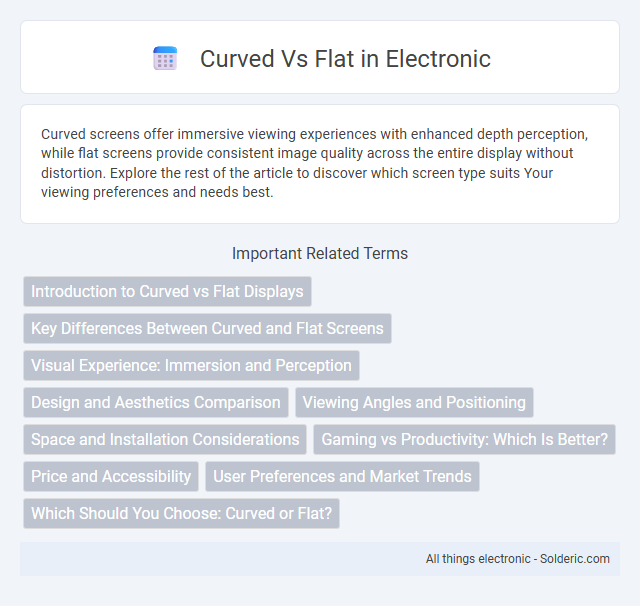Curved screens offer immersive viewing experiences with enhanced depth perception, while flat screens provide consistent image quality across the entire display without distortion. Explore the rest of the article to discover which screen type suits Your viewing preferences and needs best.
Comparison Table
| Feature | Curved Screen | Flat Screen |
|---|---|---|
| Viewing Experience | Immersive, wraps around peripheral vision | Standard, consistent from all angles |
| Glare and Reflections | Reduces glare in specific environments | More prone to glare and reflections |
| Distortion | May cause slight image distortion at edges | Minimal image distortion |
| Viewing Angles | Best viewing from center | Consistent viewing angles from all positions |
| Price | Generally higher due to design complexity | Typically more affordable |
| Space and Setup | Requires more desk space, specific placement | Flexible placement, fits most setups |
Introduction to Curved vs Flat Displays
Curved displays offer immersive viewing experiences by wrapping the screen around your field of vision, reducing distortion and enhancing depth perception compared to flat displays. Flat screens maintain uniform image quality and color accuracy across the entire surface, often preferred for professional tasks requiring precise detail. Choosing between curved and flat depends on your priorities--whether you value immersion and comfort or consistent visual performance.
Key Differences Between Curved and Flat Screens
Curved screens offer immersive viewing experiences by enhancing depth perception and reducing glare compared to flat screens, which provide a consistent, distortion-free image ideal for multitasking. The curvature radius of the screen directly affects how visuals wrap around Your field of vision, making curved displays advantageous for gaming and cinematic experiences. Flat screens are generally more affordable, compatible with wall mounting, and better suited for collaborative workspaces where multiple viewing angles are necessary.
Visual Experience: Immersion and Perception
Curved displays enhance visual experience by wrapping images around the viewer's field of vision, creating greater immersion and depth perception compared to flat screens. This curvature reduces distortion and minimizes glare, allowing for more natural eye movement and less strain during extended use. While flat screens offer uniform viewing angles, curved monitors deliver a more engaging and comfortable environment for gaming, multimedia, and professional applications.
Design and Aesthetics Comparison
Curved monitors feature sleek, immersive displays that wrap around the viewer's field of vision, enhancing depth perception and reducing distortion for a more engaging visual experience. Flat screens offer a classic, minimalist design with uniform viewing angles, making them versatile for multi-monitor setups and maintaining consistent image quality from all positions. The choice between curved and flat designs ultimately hinges on balancing immersive aesthetics and practical usability in work or gaming environments.
Viewing Angles and Positioning
Curved monitors enhance viewing angles by reducing distortion at the edges, offering a more immersive experience especially when you sit directly in front of the screen. Flat monitors maintain consistent image quality across wider positioning, making them ideal for multiple viewers or varied seating arrangements. Your choice should consider seating position and usage environment to ensure optimal visual comfort.
Space and Installation Considerations
Curved monitors demand more desk space due to their width and depth, requiring careful placement to avoid clutter, while flat monitors generally fit more easily in compact or multi-monitor setups. Installation of curved displays often requires adjustable mounts or stands to align the screen's curvature with your natural viewing angle, maximizing comfort and immersion. Your workspace layout and available space should guide the choice, as flat monitors tend to offer greater flexibility in tight or multi-screen environments.
Gaming vs Productivity: Which Is Better?
Curved monitors enhance immersive gaming experiences by offering a wider field of view and reducing distortion at the edges, making them ideal for fast-paced, visually intense games. Flat monitors provide greater precision and uniformity, which benefits productivity tasks such as graphic design, programming, and detailed spreadsheets where accurate lines and clear text are essential. For gamers seeking immersion, curved screens are preferable, while professionals focused on productivity often find flat monitors more efficient for their work.
Price and Accessibility
Curved monitors typically have a higher price point compared to flat screens due to advanced manufacturing processes and specialized display panels, making them less accessible for budget-conscious consumers. Flat monitors are widely available across various price ranges and more commonly found in retail stores and online marketplaces, offering greater accessibility and affordability. The broader market availability and competitive pricing of flat monitors make them the preferred choice for general users seeking cost-effective display solutions.
User Preferences and Market Trends
Curved monitors offer enhanced immersion and reduced eye strain, attracting gamers and creative professionals, while flat screens remain preferred for general office use due to affordability and ease of multi-monitor setups. Market trends indicate a growing demand for curved displays, with a projected compound annual growth rate (CAGR) of over 15% through 2027, driven by advancements in display technology and increasing consumer interest. User preferences fluctuate based on use cases, with esports athletes and content creators favoring curved designs for peripheral vision benefits, whereas businesses prioritize flat screens for consistent image alignment and workspace flexibility.
Which Should You Choose: Curved or Flat?
Choosing between a curved or flat display depends on your specific needs and viewing preferences. Curved screens offer immersive visuals and reduced glare, enhancing gaming and cinematic experiences, while flat screens provide consistent image quality and wider viewing angles, ideal for professional work and multitasking. Consider your workspace setup, primary use, and how much you value immersion versus accuracy to determine the best option for your display.
Curved vs Flat Infographic

 solderic.com
solderic.com